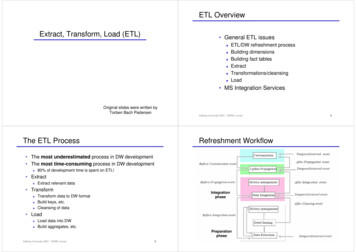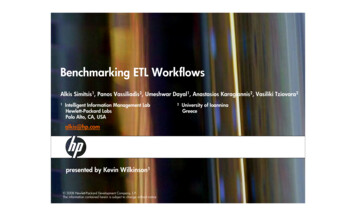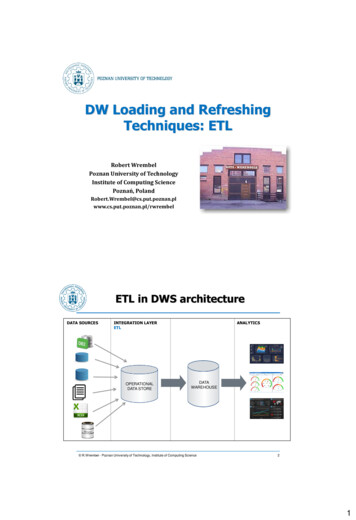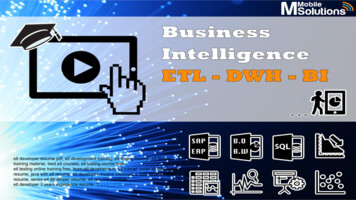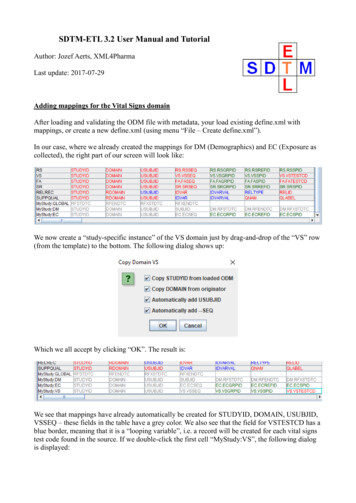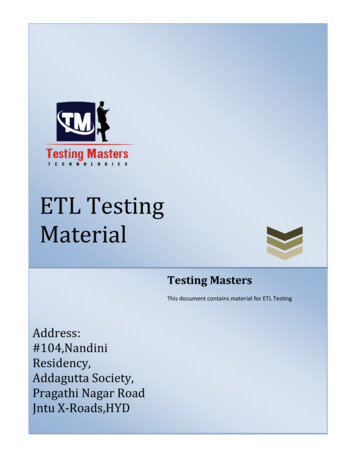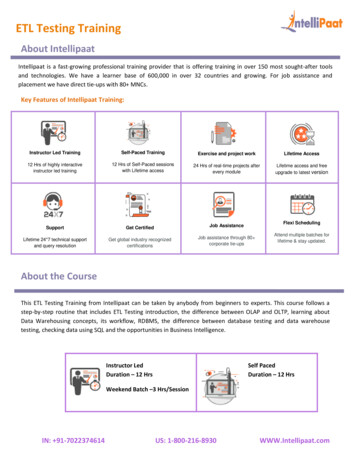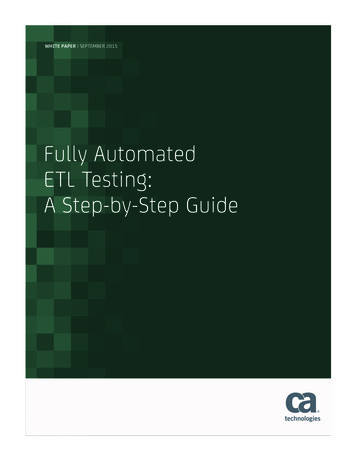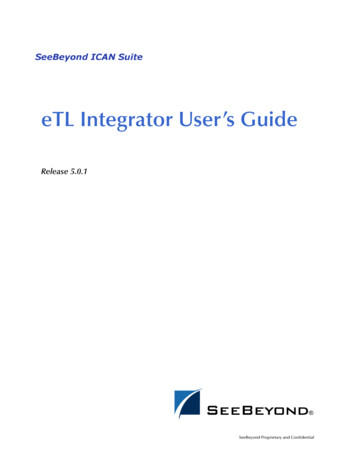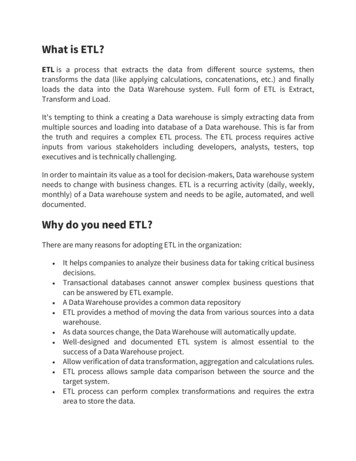
Transcription
What is ETL?ETL is a process that extracts the data from different source systems, thentransforms the data (like applying calculations, concatenations, etc.) and finallyloads the data into the Data Warehouse system. Full form of ETL is Extract,Transform and Load.It's tempting to think a creating a Data warehouse is simply extracting data frommultiple sources and loading into database of a Data warehouse. This is far fromthe truth and requires a complex ETL process. The ETL process requires activeinputs from various stakeholders including developers, analysts, testers, topexecutives and is technically challenging.In order to maintain its value as a tool for decision-makers, Data warehouse systemneeds to change with business changes. ETL is a recurring activity (daily, weekly,monthly) of a Data warehouse system and needs to be agile, automated, and welldocumented.Why do you need ETL?There are many reasons for adopting ETL in the organization: It helps companies to analyze their business data for taking critical businessdecisions.Transactional databases cannot answer complex business questions thatcan be answered by ETL example.A Data Warehouse provides a common data repositoryETL provides a method of moving the data from various sources into a datawarehouse.As data sources change, the Data Warehouse will automatically update.Well-designed and documented ETL system is almost essential to thesuccess of a Data Warehouse project.Allow verification of data transformation, aggregation and calculations rules.ETL process allows sample data comparison between the source and thetarget system.ETL process can perform complex transformations and requires the extraarea to store the data.
ETL helps to Migrate data into a Data Warehouse. Convert to the variousformats and types to adhere to one consistent system.ETL is a predefined process for accessing and manipulating source data intothe target database.ETL in data warehouse offers deep historical context for the business.It helps to improve productivity because it codifies and reuses without aneed for technical skills.ETL Process in Data WarehousesETL is a 3-step processStep 1) ExtractionIn this step of ETL architecture, data is extracted from the source system into thestaging area. Transformations if any are done in staging area so that performanceof source system in not degraded. Also, if corrupted data is copied directly from thesource into Data warehouse database, rollback will be a challenge. Staging area
gives an opportunity to validate extracted data before it moves into the Datawarehouse.Data warehouse needs to integrate systems that have differentDBMS, Hardware, Operating Systems and Communication Protocols. Sourcescould include legacy applications like Mainframes, customized applications, Pointof contact devices like ATM, Call switches, text files, spreadsheets, ERP, data fromvendors, partners amongst others.Hence one needs a logical data map before data is extracted and loaded physically.This data map describes the relationship between sources and target data.Three Data Extraction methods:1. Full Extraction2. Partial Extraction- without update notification.3. Partial Extraction- with update notificationIrrespective of the method used, extraction should not affect performance andresponse time of the source systems. These source systems are live productiondatabases. Any slow down or locking could effect company's bottom line.Some validations are done during Extraction: Reconcile records with the source dataMake sure that no spam/unwanted data loadedData type checkRemove all types of duplicate/fragmented dataCheck whether all the keys are in place or notStep 2) TransformationData extracted from source server is raw and not usable in its original form.Therefore it needs to be cleansed, mapped and transformed. In fact, this is the keystep where ETL process adds value and changes data such that insightful BI reportscan be generated.
It is one of the important ETL concepts where you apply a set of functions onextracted data. Data that does not require any transformation is called as directmove or pass through data.In transformation step, you can perform customized operations on data. Forinstance, if the user wants sum-of-sales revenue which is not in the database. Or ifthe first name and the last name in a table is in different columns. It is possible toconcatenate them before loading.Data Integration IssuesFollowing are Data Integrity Problems:1.2.3.4.Different spelling of the same person like Jon, John, etc.There are multiple ways to denote company name like Google, Google Inc.Use of different names like Cleaveland, Cleveland.There may be a case that different account numbers are generated byvarious applications for the same customer.5. In some data required files remains blank6. Invalid product collected at POS as manual entry can lead to mistakes.Validations are done during this stage Filtering – Select only certain columns to loadUsing rules and lookup tables for Data standardization
Character Set Conversion and encoding handlingConversion of Units of Measurements like Date Time Conversion, currencyconversions, numerical conversions, etc.Data threshold validation check. For example, age cannot be more than twodigits.Data flow validation from the staging area to the intermediate tables.Required fields should not be left blank.Cleaning ( for example, mapping NULL to 0 or Gender Male to "M" andFemale to "F" etc.)Split a column into multiples and merging multiple columns into a singlecolumn.Transposing rows and columns,Use lookups to merge dataUsing any complex data validation (e.g., if the first two columns in a row areempty then it automatically reject the row from processing)Step 3) LoadingLoading data into the target datawarehouse database is the last step of the ETLprocess. In a typical Data warehouse, huge volume of data needs to be loaded in arelatively short period (nights). Hence, load process should be optimized forperformance.In case of load failure, recover mechanisms should be configured to restart fromthe point of failure without data integrity loss. Data Warehouse admins need tomonitor, resume, cancel loads as per prevailing server performance.Types of Loading: Initial Load — populating all the Data Warehouse tablesIncremental Load — applying ongoing changes as when neededperiodically.Full Refresh —erasing the contents of one or more tables and reloading withfresh data.Load verification Ensure that the key field data is neither missing nor null.
Test modeling views based on the target tables.Check that combined values and calculated measures.Data checks in dimension table as well as history table.Check the BI reports on the loaded fact and dimension table.ETL ToolsThere are many Data Warehousing tools are available in the market. Here, aresome most prominent one:1. MarkLogic:MarkLogic is a data warehousing solution which makes data integration easier andfaster using an array of enterprise features. It can query different types of data likedocuments, relationships, and metadata.2. Oracle:Oracle is the industry-leading database. It offers a wide range of choice of DataWarehouse solutions for both on-premises and in the cloud. It helps to optimizecustomer experiences by increasing operational efficiency.3. Amazon RedShift:Amazon Redshift is Datawarehouse tool. It is a simple and cost-effective tool toanalyze all types of data using standard SQL and existing BI tools. It also allowsrunning complex queries against petabytes of structured data.Best practices ETL processFollowing are the best practices for ETL Process steps:Never try to cleanse all the data:Every organization would like to have all the data clean, but most of them are notready to pay to wait or not ready to wait. To clean it all would simply take too long,so it is better not to try to cleanse all the data.Never cleanse Anything:
Always plan to clean something because the biggest reason for building the DataWarehouse is to offer cleaner and more reliable data.Determine the cost of cleansing the data:Before cleansing all the dirty data, it is important for you to determine thecleansing cost for every dirty data element.To speed up query processing, have auxiliary views and indexes:To reduce storage costs, store summarized data into disk tapes. Also, the trade-offbetween the volume of data to be stored and its detailed usage is required. Tradeoff at the level of granularity of data to decrease the storage costs.Summary: ETLstands for Extract, Transform and Load.ETL provides a method of moving the data from various sources into a datawarehouse.In the first step extraction, data is extracted from the source system into thestaging area.In the transformation step, the data extracted from source is cleansed andtransformed .Loading data into the target datawarehouse is the last step of the ETLprocess.How to write a TEST CASE Software Testing Tutorial
ETL is a process that extracts the data from different source systems, then transforms the data (like applying calculations, concatenations, etc.) and finally loads the data into the Data Warehouse system. Full form of ETL is Extract, Transform and Load. It's tempting to think a creating a Data warehouse is simply extracting data from multiple sources and loading into database of a Data .
